In today’s urbanized world, finding ways to maximize limited gardening space is both a challenge and an opportunity to innovate. Creating efficient layouts for small gardens allows homeowners to transform small spaces into lush, productive sanctuaries.
Experts at Luke’s Landscaping emphasize combining thoughtful design elements with practical features to create efficient small garden layouts.
Similarly, GrowVeg highlights the value of vertical planting and multifunctional zones in creating dynamic and small garden layouts. This means carefully selecting plants that complement each other, using structures like trellises or planters to add vertical interest, and creatively utilizing every inch of space to balance beauty and functionality. Explore creative layout ideas to maximize vegetable garden yield.
Understand Your Space for Efficient Garden Layouts
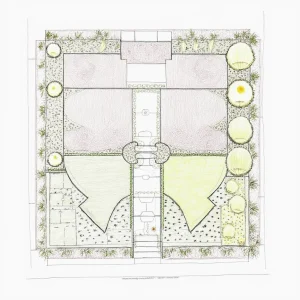
Before designing efficient layouts for small gardens, it’s crucial to assess sunlight exposure and available space
Measure and Map Your Garden
To begin, measure your garden’s dimensions. Afterwards, make a simple sketch to visualize your available space. Consider both horizontal and vertical dimensions to spot hidden opportunities for expanding your planting area.
- Create a Scaled Diagram: Use graph paper or online tools to create a scaled version of your space, which helps in accurate planning.
- Include Existing Elements: Incorporate existing plants, furniture, or structures in your sketch for a clearer view of available planting zones.
- Identify Underutilized Areas: Look for underutilized areas, such as fence lines or corners, that can be optimized with planters or climbing plants.
- Plan for Future Growth: Additionally, consider future growth, leaving enough room for plants to expand without overcrowding your garden.
Sunlight & Microclimates in Efficient Small Gardens
Next, observe how sunlight moves across your garden throughout the day. Identify sunny, shady, and partially shaded areas.
- Use Sunlight Mapping Tools: Utilize apps or tools to map sunlight patterns for accuracy.
Assess Microclimates
Furthermore, take note of temperature variations, wind exposure, and natural shelter within your garden.
- Plant Wind-Resistant Species: For example, plant wind-resistant species like ornamental grasses or junipers in exposed areas.
- Utilize Natural Shelters: Use natural shelters like walls or fences to support heat-loving plants such as tomatoes.
- Prevent Disease: I have seen more than once where a combination of heat and moisture in areas with poor airflow can create conditions favorable for diseases like late blight in tomatoes. To prevent this, ensure proper spacing between plants for free air circulation, avoid structures that can excessively trap moisture, and prune regularly to reduce foliage density.
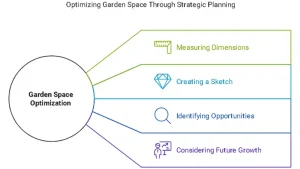
Strategic Design Principles for Efficient Small Gardens
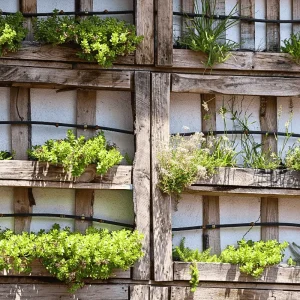
A practical example of vertical gardening that maximizes small space using upcycled wood and efficient irrigation.
Once you’ve analyzed your space, it’s time to implement design strategies tailored for compact gardens. By implementing vertical gardening, raised beds, and multifunctional elements, you can create efficient layouts for small gardens that maximize productivity without overcrowding your space.
Vertical Gardening in Efficient Small Garden Layouts
Vertical gardening is an essential component of efficient layouts for small gardens, optimizing space for better productivity:
Use trellises, wall-mounted planters, and hanging baskets to grow herbs, flowers, and climbing vegetables. Clematis, peas, and ivy thrive when given height.
Install vertical towers for crops like strawberries, leafy greens, or small peppers.
Choose pocket planters to create living walls that enhance aesthetics and productivity while providing natural insulation for outdoor walls.
Raised Beds and Containers for Efficient Small Gardens
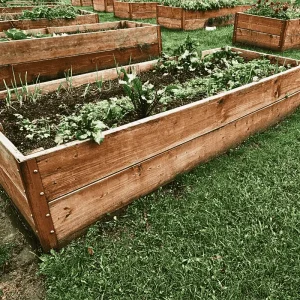
Raised Beds optimize soil conditions, define garden zones, and improve access in small spaces. Use modular raised beds to rearrange your layout as needed.
Container Gardening: Containers are perfect for flexible layouts and are ideal for urban or balcony gardens. Choose stackable or tiered containers for added efficiency. Self-watering containers are an excellent choice for reducing maintenance.
Edging with Containers: : Line walkways or seating areas with potted plants to add greenery without occupying central garden space.
Multifunctional Elements
Use benches with built-in storage for tools and gardening supplies.
Incorporate planters that double as seating or decorative features. Some planters also come with integrated trellises for climbing plants.
Consider foldable furniture that can be stored away when not in use.
Smart Plant Selection
Choosing the right plants ensures that your garden thrives despite size constraints:
Compact Varieties: Look for dwarf or bush versions of vegetables like tomatoes, cucumbers, and peppers. Smaller fruit trees, like dwarf lemons, are perfect for patios.
Companion Planting: Combine plants that support each other’s growth, such as basil with tomatoes or marigolds with beans. This approach also deters pests and optimizes nutrients.
High-Yield Crops: Focus on plants that produce abundantly in small areas, like salad greens, radishes, and pole beans. Try varieties specifically bred for container gardening.
Plan your layouts based on seasonal planting schedules for the best results.
Creating Zones & Pathways in Efficient Small Garden Layouts
Organizing small spaces into functional sections is the foundation of efficient layouts for small gardens, ensuring both aesthetics and usability
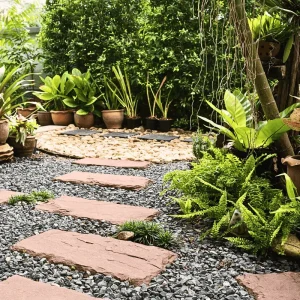
Harmonizing Functionality and Aesthetics for Small Garden Layouts
Efficient layouts are about creating harmony between functionality and aesthetics. As highlighted by GrowVeg combining thoughtful design with practical features, such as raised beds and clearly defined zones, enhances both utility and visual appeal.
How to Designate Zones for Efficient Small Garden Layouts
To begin with, designate areas for specific purposes, such as planting, relaxation, and storage. Luke’s Landscaping recommends using raised beds and vertical planters to clearly delineate zones while maintaining functionality. Similarly, GrowVeg suggests compact designs and layering strategies to maximize utility. For instance, a small seating area with potted lavender can double as a pollinator-friendly zone, blending beauty with productivity.
Incorporate Functional Pathways
Furthermore, use narrow, winding paths to guide movement while maximizing planting areas. Materials like gravel, stepping stones, or wooden planks work well in small gardens. Additionally, adding borders with low-growing plants like thyme or creeping sedum enhances the aesthetic appeal.
Utilizing Creative Shapes in Efficient Small Garden Layouts
Moreover, choose circular or triangular planting zones to utilize corners and awkward spaces. Curved edges can make small spaces feel larger, creating a more inviting environment.
Water and Maintenance Considerations in Efficient Small Gardens
Smart irrigation and low-maintenance plants are vital components of efficient layouts for small gardens, allowing for sustainability
Efficient Water Use and Minimal Maintenance
Efficient water use and minimal maintenance are critical for small gardens. For instance, integrating IoT-based water management systems, such as smart sensors that monitor soil moisture and automate irrigation schedules, not only saves time and resources but also ensures plants receive optimal hydration. As a result, plants remain healthy with minimal effort. Incorporating smart irrigation and drought-resistant plants into efficient layouts for small gardens helps reduce maintenance efforts while conserving water.
Choosing Irrigation Systems for Efficient Small Garden Layouts
To begin with, choosing the right irrigation system can make a significant difference in water conservation. For example, drip irrigation or self-watering pots can effectively save time while simultaneously reducing water waste. In addition, smart irrigation systems connected to IoT devices are particularly useful as they automate watering schedules based on real-time weather data, thus preventing over- or under-watering.
Best Low-Maintenance Plants for Efficient Small Garden Layouts
Moreover, selecting the right plants is crucial in minimizing garden upkeep. To reduce effort, opt for drought-tolerant or perennial plants that require minimal watering. For example, succulents, ornamental grasses, and herbs like rosemary are excellent choices since they thrive in dry conditions. Not only that, but these plants also add aesthetic appeal to the garden while requiring little maintenance.
Mulching
Furthermore, applying organic mulch can significantly benefit the soil. By doing so, it helps retain moisture, regulate temperature, and suppress weed growth. Additionally, mulch enhances soil fertility over time as it decomposes, making it a sustainable choice for any small garden.
Rainwater Harvesting
In addition to smart irrigation systems, rainwater harvesting is another effective method for conserving water. For instance, installing a small rain barrel or using decorative water features that double as reservoirs allows gardeners to collect and reuse rainwater. As a result, less reliance on municipal water sources helps reduce costs while supporting sustainable gardening practices.
Budget-Friendly and Seasonal Adaptation Ideas for Small Gardens
Gardening doesn’t have to break the bank. Here are some cost-effective tips:
Upcycle Materials: Use old crates, pallets, or tin cans as planters. Paint them to match your garden’s theme.
DIY Features: Create garden decor or trellises from reclaimed wood or recycled metal. Make stepping stones from broken tiles or cement molds.
Seasonal Adjustments: Rotate crops based on seasons to ensure year-round productivity. Consider using cold frames or cloches to extend the growing season in winter.
Special Tips for Urban and Balcony Gardens
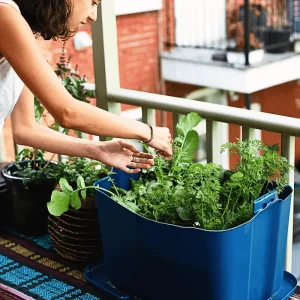
Urban gardens come with unique challenges, but these tips can help:
Use lightweight containers to prevent balcony overload. Fabric grow bags are a great lightweight option.
Add privacy with tall plants or screens of climbing vines. Bamboo screens paired with passionflowers create a natural divider.
Install compact compost bins to recycle kitchen waste efficiently. Worm composting is another excellent option for urban settings.
Use reflective surfaces, like mirrors or light-colored walls, to increase light in shady areas.
Visualizing Efficient Small Garden Layouts
A well-drawn layout can inspire and guide your garden design. Consider these ideas:
Draw zones for different plant types and pathways. Highlight multi-use areas.
Incorporate vertical elements and raised beds into the sketch. Use color coding for plant types and garden features.
Plan for multifunctional furniture or decorative features, balancing utility and aesthetics.
Experiment with online garden design tools to visualize your layout before implementation.
Conclusion
As someone passionate about sustainable gardening and modern agricultural technologies, I’ve spent years refining strategies to make every square meter of space count. You can transform even the most miniature garden into a functional and beautiful haven.
With thoughtful planning and innovative strategies, even the most miniature garden can be a thriving, beautiful space. Remember to experiment, adapt, and make it personal—gardens are as much about creativity as functionality. Whether planting your first container garden on a balcony or redesigning a tiny backyard, these tips will help you create an efficient and rewarding space.
I always believed that most mistakes in garden set–up can be avoided at the very start. Don’t copy and paste all the features you see in established gardens or garden magazines; rather, try to visualize them first in your own garden conditions. Avoid sudden major changes. Try to implement it on a small scale—that way, mistakes can be rectified more easily.
I hope this inspires you to embrace the challenge of small gardening spaces. Share your tips or photos of your garden—I’d love to see how you’ve flourished your space!
Before You Go—Grab This Free Guide- On How to Create Your Own Efficient Layout for Small Garden!
Take your gardening journey to the next level with our exclusive 8-page guide: How to Create Efficient Layouts for Small Gardens . Packed with actionable tips and creative ideas, this guide will transform your approach to gardening in compact spaces.
Click the button below to download your free copy and start planning your productive garden today!








